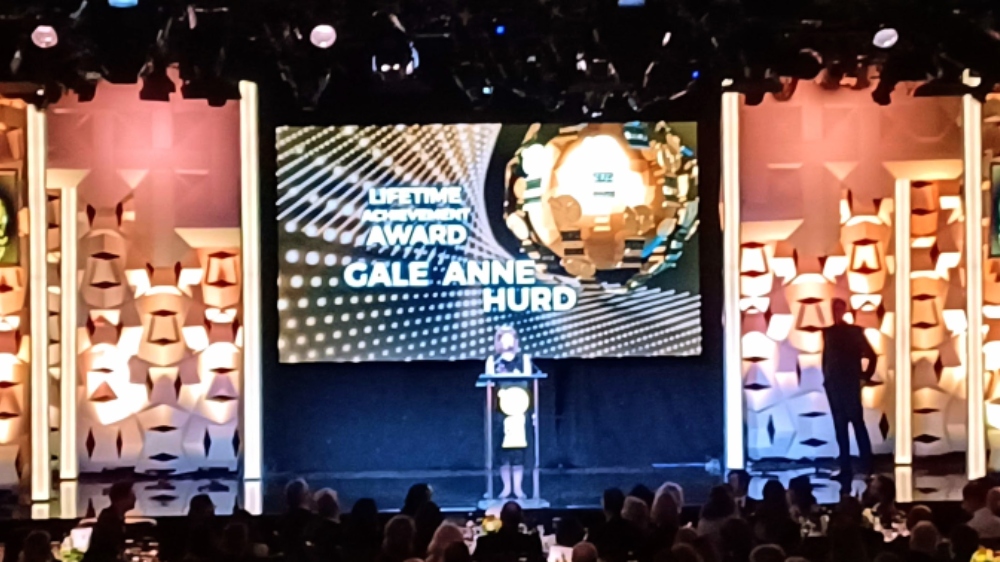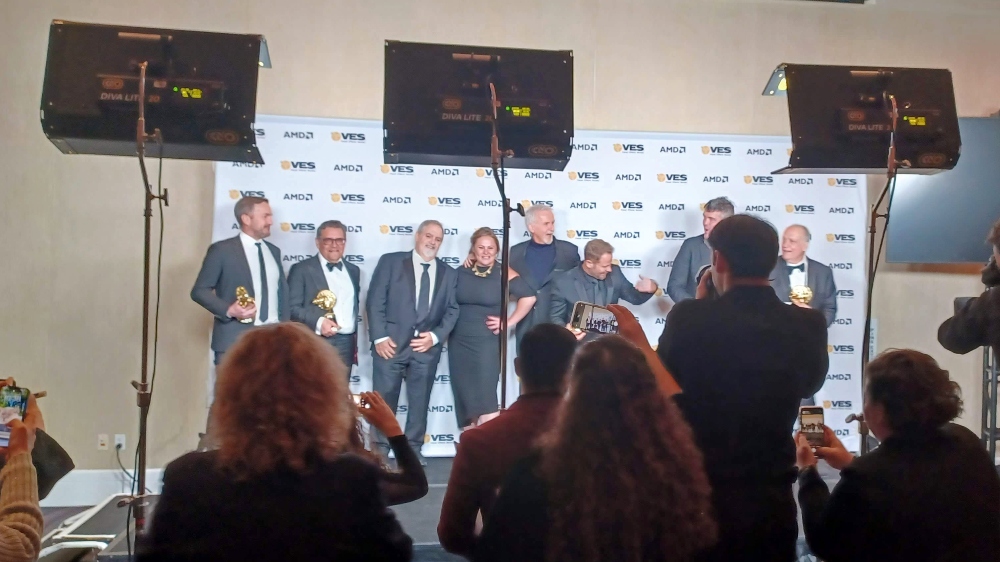In an age of instant news, one no longer needs to “wait” on things like football scores or tallies from award shows. They are live-posted and generally available as soon as you have a hankering to know them, right on that formerly NASA-sized computer in your pocket. (Or are you just glad to see us?)
No, while things like, say, justice can take generations, news of results is usually instantaneous. So you already know that Avatar: The Way of Water commenced its Sherman’s March toward the VFX Oscar next month, with a sweep of every category it was nominated in at the Visual Effects Society Awards, held on the Ides of February, at its now familiar Beverly Hilton locale.
And as Below the Line Editor-in-Chief Jeff Sneider already pointed out (in his quickly turned-around reportage), the only categories that Avatar lost in were ones where it was competing against itself.
Indeed, Avatar set a record for most VES nominations ever, and while the cutting-edge artistry of the film is clear, we might also note that there are more VES categories than ever before, too.
Having been on this beat for a soberingly long time, one remembers when the VES, as the new awards kid on the block, used to meet in venues like the Hollywood Palladium. That was their third annual award ceremony — this year’s was their 21st — and back then there were just 19 categories. While the difference between that figure and the current number of 25 isn’t terribly vast, you can also chart how things have changed with how the various divisions have either disappeared or been renamed, many having gone the way of the “black and white cinematography” category at the Oscars, with more emphasis now on effects in real life venues, commercials, and video games.

Then, as now, what was essentially the VES version of “Best Picture” was subdivided: One category for “Outstanding Visual Effects in an Effects-Driven Picture” — usually a genre picture where you’d expect effects (the most recent Harry Potter installment won that year) – and then one for “Outstanding Supporting Visual Effects in a Motion Picture.” That usually meant more “realistic” looking films, where you didn’t necessarily expect to see “effects,” though Rob Legato won then for his work in Martin Scorsese‘s The Aviator, and viewers doubtless guessed they weren’t watching real planes crashing into actual Beverly Hills neighborhoods.
VES also had a category that’s still missed: Best Single Visual Effect of the Year.” The tidal wave from Independence Day won, back in that Sunset Blvd. venue. How would you even judge that award now? This or that de-aging of an actor? This conflagration or that earthquake? That recreation of a soon-to-be-extinct animal species roaming the savannahs or rainforests?
Exactly. So as digital work gets more pervasive, so do categories at the VES. And while there are still “main” and “supporting” categories in the evening’s final two “Best Picture” categories, each now is for effects in a “photoreal” feature, which may blur the whole idea of what we even consider “effects-driven” now. Or perhaps concedes that pretty much everything is.
(Outside of “photoreal” there are the entrancingly animated offerings, with this year’s big winner being, of course, Guillermo del Toro’s Pinocchio.)
But in this A.I.-ish world we’ve now entered (and just since we began charting A.I.’s potential effects on production in this space, ChatGPT, released late last fall, is now said to have the mind of a 9-year-old child), what is even meant by “photoreal?” And to what degree will A.I. give rise to new, previously unreckoned categories at the VES?
Given that the Avatar sequel was competing against the likes of the latest Jurassic Park, along with new Top Gun and Batman offerings, what is currently meant by “real” looking film? Is Tom Cruise in a fighter jet, then, no more or less “real” than tall blue denizens of a foreign planet?
Or just slightly less “real” than, say, Kenneth Branagh as Hercule Poirot, in Death on the Nile? That was nominated in the “supporting” category, ultimately won by Ron Howard‘s Thai cave rescue drama Thirteen Lives, which, by implication, made good use of innovations in artifice to tell its “real life” story. Or “photoreal” one.
Though Walter Benjamin-like musings aside about what constitutes “reality” in our art, it was certainly an Avatar night.

Besides all the film’s wins, James Cameron was there not only to watch his fellow Avatar crew members and Weta FX collaborators head to the podium for numerous statues but to introduce ex-wife and original producing partner Gale Anne Hurd (Terminator and Aliens, among their early breakthroughs together) for a lifetime achievement award.
Cameron spoke of their time “working together in the trenches” for Roger Corman, mastering the early analog “tricks” of visual effects — rear and front screen projections, matte paintings, et al — and then realizing, during the Abyss and Terminator 2 phases of their careers, that CG visual effects were coming, and were “about to bulldoze everything in [their] path.”
Hurd recounted spending weekends in the cinema, where “Ray Harryhausen was my first visual effects crush” (as he was, really, for many of us of a certain age), then being hired by Roger Corman on the basis of a thesis she’d written at Stanford on the widespread effect of the effects, as it were, in 2001: A Space Odyssey.
She opined that it must have been the thesis that got her hired since she didn’t recall doing very well in the “in-person” part of the interview, adding that that was long before such things were deferred to Zoom.
She also ventured that there was another little girl out there somewhere right now, being inspired by today’s VFX workers.
Which is doubtless true. It’s just unclear if that little girl is going to grow up working in “movies,” as they have been known — photoreal or otherwise — or VR or AR (or A.I.) projects, and how, eventually, the digital parts of her life will become distinguishable from the rest.
Director Rian Johnson, he of recent whodunit fame, was on hand to present some awards, too, including those for FX work in “special venues” — which is to say, places we may encounter such effects more or less “live,” away from theaters. “Here are the nominees,” he joked. “Or as I call them, the enemies of my content.”
But “content,” for better or worse, is everywhere now. All of it seemingly equally “real.” Or photoreal.
Though Philip K. Dick, another writer who wrestled with what was “actually” real, said, “reality is that which, when you stop believing in it, doesn’t go away.”
Which begs the interesting question of what reality will be believed in next, after the loss of faith in the current one. Or perhaps because the new one somehow seems more, well, authentic.
It may certainly give rise to new award categories.
The VES Awards are legally able to drink this year, and in that spirit, I’ll raise a glass to this year’s show and the promise of next year’s, too. See you then.
 Mark London Williams is a BTL alum who currently covers Hollywood, its contents and discontents, in his recurring “Across the Pond” dispatch for British Cinematographer magazine, contributes to other showbiz and production-minded sites, and musters out the occasional zombie, pandemic-themed, or demon-tinged book and script, causing an increased blurring in terms of what still feels like “fiction.”
Mark London Williams is a BTL alum who currently covers Hollywood, its contents and discontents, in his recurring “Across the Pond” dispatch for British Cinematographer magazine, contributes to other showbiz and production-minded sites, and musters out the occasional zombie, pandemic-themed, or demon-tinged book and script, causing an increased blurring in terms of what still feels like “fiction.”
Mark London Williams’ Union Roundup column will appear every Tuesday. You can reach him to give him tips and feedback at [email protected]. He can also be found on Twitter @TricksterInk.





